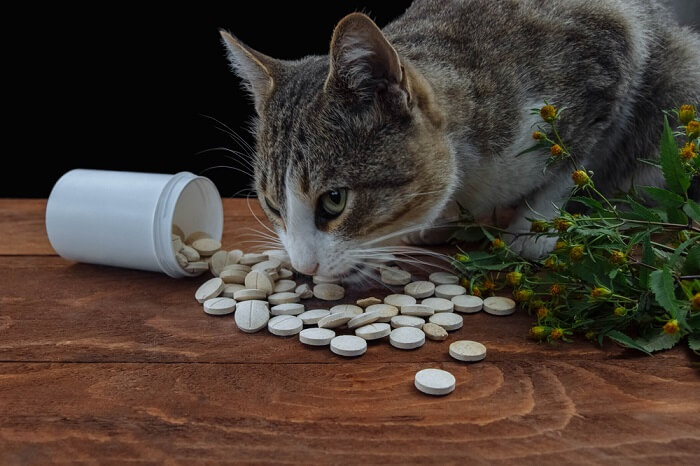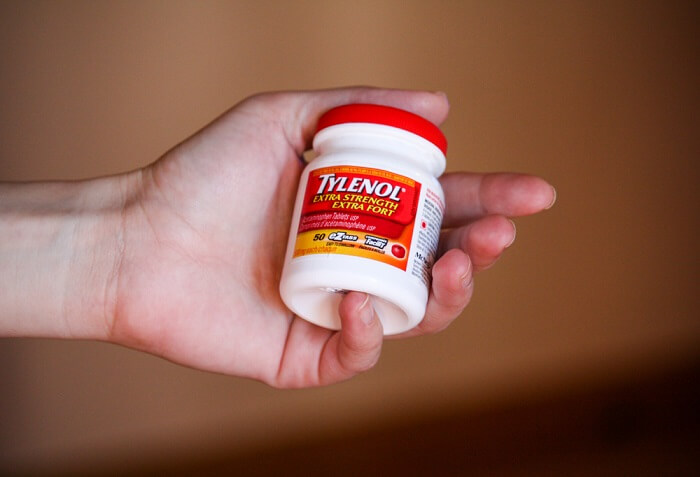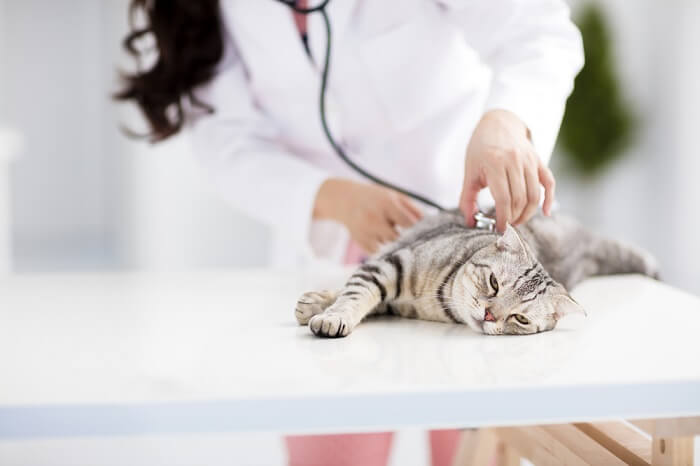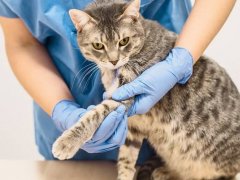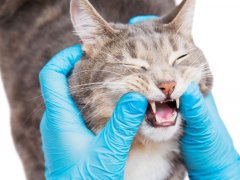Tylenol (acetaminophen or paracetamol) is a common poison to affect cats, and it’s often fatal. This article aims to explain the background to Tylenol poisoning, helping cat owners to understand why it happens, what can be done if their cat is affected, and how to prevent it from happening in the first place.
Quick Overview: Tylenol Poisoning in Cats
 Other Names: Paracetomol poisoning
Other Names: Paracetomol poisoning
 Common Symptoms: Dullness, weakness, poor appetite, rapid breathing, brown/grey or yellow gums, gastrointestinal upset.
Common Symptoms: Dullness, weakness, poor appetite, rapid breathing, brown/grey or yellow gums, gastrointestinal upset.
 Diagnosis: History of exposure to Tylenol, findings consistent with the disease on physical exam, bloodwork (anemia, Heinz bodies, liver enzyme elevations, elevated bilirubin, elevated kidney values), methemoglobin levels, acetaminophen levels, urine samples (bilirubin, hemaglobin, glucose)
Diagnosis: History of exposure to Tylenol, findings consistent with the disease on physical exam, bloodwork (anemia, Heinz bodies, liver enzyme elevations, elevated bilirubin, elevated kidney values), methemoglobin levels, acetaminophen levels, urine samples (bilirubin, hemaglobin, glucose)
 Requires Ongoing Medication: No
Requires Ongoing Medication: No
 Treatment Options: N-acetylcysteine, methylene blue, cimetidine, S-adenosylmethionine (SAMe), Vitamin C, glutathione, oxygen support, intravenous fluids, hospitalization.
Treatment Options: N-acetylcysteine, methylene blue, cimetidine, S-adenosylmethionine (SAMe), Vitamin C, glutathione, oxygen support, intravenous fluids, hospitalization.
 Home Remedies: No
Home Remedies: No
About Tylenol Poisoning in Cats
Tylenol is the brand name for a drug called acetaminophen in North America, and paracetamol in Europe. Panadol is another common brand that includes the drug as an active ingredient. It is an over-the-counter medication that’s widely used for its analgesic (pain relief) and antipyretic (anti-fever) properties in humans (and sometimes dogs). Its mode of action is still unknown.
Can You Give a Cat Tylenol?
Even when the dose of acetaminophen is low for other species, the toxic dose for cats is low, and cats are so vulnerable to toxic effects that serious damage can easily be done.
The drug is similar to ibuprofen in the way that it is a safe pain reliever for human medication but highly dangerous for cats.
Tylenol is mostly metabolised by conversion to inactive compounds by conjugation with sulfate and glucuronide. Cats only have low levels of the enzyme glucuronyl transferase which is needed to produce these conjugates, which means that the drug cannot be metabolised as quickly as in other species, and different metabolic pathways are used which produce damaging metabolites of Tylenol.
This makes cats highly vulnerable to toxicity from Tylenol compared to other species. Acetaminophen toxicity can follow from a single dose of Tylenol, at doses as low as 10mg/kg which would be safe in other species.
The most common cause of poisoning with Tylenol in cats is when an owner gives the medication to their pet, making it especially important that people are informed that this is not a drug that is safe to be used in the treatment of cats.
How Tylenol Affects Cats
Tylenol affects your cat’s body differently than it does your own. It causes damage to the red blood cells, leading to serious complications.
Tylenol toxicity causes two issues in the cat: methemoglobinemia and hepatotoxicity.
The breakdown products of Tylenol in cats damage the red blood cells, causing increased levels of methemoglobin. This is known as methemoglobinemia. Oxygen is normally carried in the bloodstream by hemoglobin, a protein that’s attached to red blood cells.
Hemoglobin then releases that oxygen to cells throughout the body. Methemoglobin is a different type of hemoglobin which also carries oxygen in the blood but doesn’t release it to the cells. Signs of methemoglobinemia include dullness, weakness, rapid breathing (tachypnea), cyanosis (purplish gums) and difficulty breathing (dyspnea).
The consequences of the poor ability of cats to metabolize Tylenol in cats also results in live damage (hepatotoxicity) causing signs of liver failure, including dullness, inappetence, jaundice (icterus), vomiting and potentially death.
Symptoms of Tylenol Poisoning in Cats
Tylenol causes clinical signs in cats caused by methemoglobinemia and hepatotoxicity. These include dullness, weakness, inappetence, rapid breathing, cyanosis, jaundice, gastrointestinal upset including vomiting, and death. Edema of the extremities (feet) may be seen.
Occasionally, affected cats suffer the additional problem of dry eye, caused by reduced tear production.
Diagnosis of Tylenol Poisoning in Cats
1. Detailed History Taking
Your vet will discuss every aspect of your cat’s background and overall care. The circumstances will often give rise to a suspicion of Tylenol exposure (e.g. an owner giving their pet this medication). The amount of acetaminophen that has been given is significant, and a local animal poison control center may be contacted as part of this initial discussion.
2. Physical Examination
Your veterinarian will check your cat over carefully, checking for any signs suggestive of Tylenol poisoning. In particular, examination of the mucous membranes for jaundice or cyanosis is important.
3. Routine Blood Tests
It’s very likely that your DVM veterinarian may carry out routine blood work, including the usual panel of diagnostic tests, such as hematology (blood count) and biochemistry profiles.
Characteristic findings include anemia (low red blood cell count), with the presence of so-called Heinz bodies on the blood film (these are small flecks that are seen on red blood cells, caused by the damaged hemaglobin). Biochemical changes include raised liver enzymes, raised kidney parameters, and elevated bilirubin (jaundice).
4. Specialised Blood Tests
Methemaglobin may be identified in specific blood tests.
If there is uncertainty about the diagnosis, it may be possible to get serum Tylenol (acetaminophen) levels measured at a local human hospital toxicology department.
5. Urine Tests
Routine urine tests (urinalysis) may identify the presence of bilirubin and hemaglobin in the urine, and glucose may be present. Urine sediment may contain so-called casts, with blood cells.
6. Other Tests
Biopsies of the kidneys and liver may show characteristic changes but it is uncommon for these to be carried out.
Treatment of Tylenol Poisoning in Cats
There are several forms of treatment for Tylenol poisoning in cats.
Induction of emesis (vomiting) can be an effective way of removing the Tylenol from the cat’s stomach if this is carried out promptly enough (ideally within half an hour of ingestion).
Additional treatment for acetaminophen toxicosis is important even if this is carried out. Activated charcoal may also be recommended in an attempt to limit absorption of Tylenol from the digestive tract.
Specific treatment includes:
Methemaglobinemia
- Acetylcysteine. This does not directly reduce methemoglobin but it alters the cats metabolism to make it easier for the methemaglobin to be managed.
- Methylene blue. This aims to reduce methemoglobin levels but it is challenging to dose this correctly in cats, and it can even make the problem worse, so many veterinarians may not agree with this treatment.
- Cimetidine may help to slow the breakdown of acetaminophen into toxic metabolites
- Silymarin and glutathione have also been used in the past but their efficacy is uncertain.
Liver Damage
- SAM-e (an antioxidant and liver protectant medication), n-Acetylcysteine, and ascorbic acid (Vitamin C) may all be recommended.
General supportive treatment is also important, including intravenous fluid therapy (and perhaps blood transfusions), B vitamins, anti-emetics, and good nursing care (eg to maintain normal body temperature).
Intensive monitoring, including repeated blood tests, is an important part of the care of these patients. Artificial tears may be given if a cat is suffering from dry eye.
Prevention of Tylenol Poisoning in Cat
Pet owners should store Tylenol safely, out of the reach of pets, and the medication should never be given to cats.
Conclusion
Tylenol poisoning is a common poisoning in cats, usually caused by the administration of the medication to a pet cat by an owner. If a cat is known to ingest this medication, prompt action by taking the cat to the emergency veterinarian is essential and can be life-saving.
Frequently Asked Questions
What are the signs of Tylenol poisoning in a cat?
Typical signs include dullness, weakness, inappetence, rapid breathing, cyanosis, jaundice, vomiting, and death.
Can Cats Take Tylenol?
Tylenol should never be given by an owner to a cat, unless this has been specifically recommended in rare, specific, situations at carefully measured doses under the direct supervision of a veterinarian.
How do you treat Tylenol toxicity in cats?
Initial steps include removal of the drug from the stomach by inducing vomiting and reducing absorption by giving activated charcoal. Emergency veterinary treatment may include medication to limit the impact of the damage caused by Tylenol, along with general supportive care.
Can Tylenol PM kill a cat?
Unfortunately, Tylenol poisoning is often fatal within two or three days of administration.
